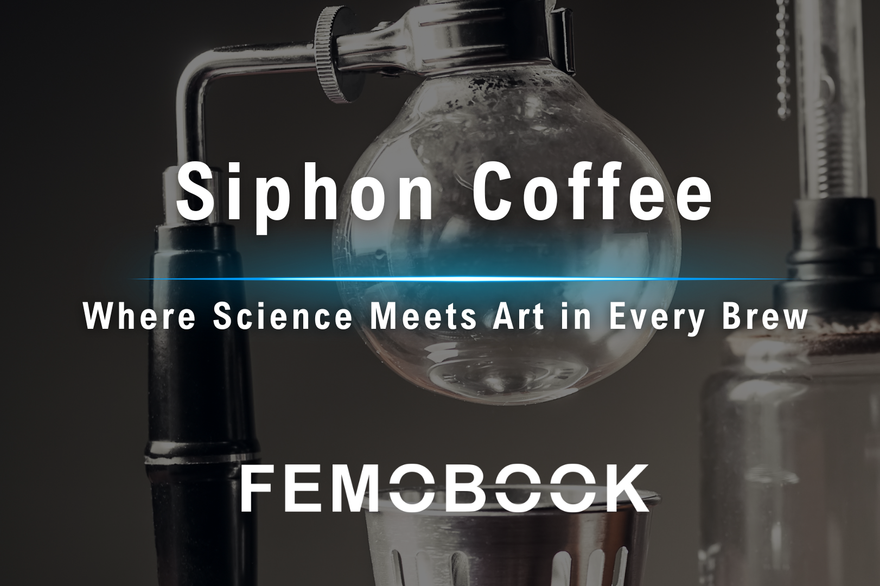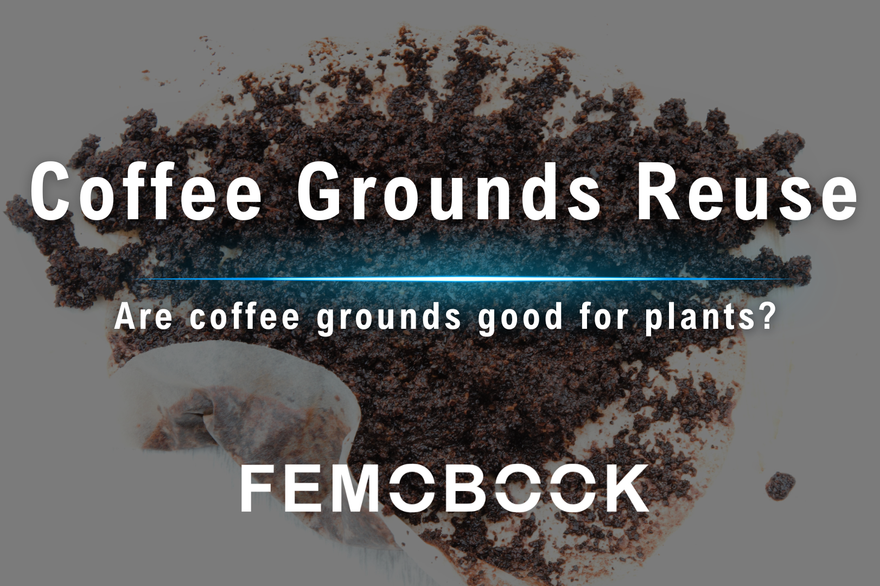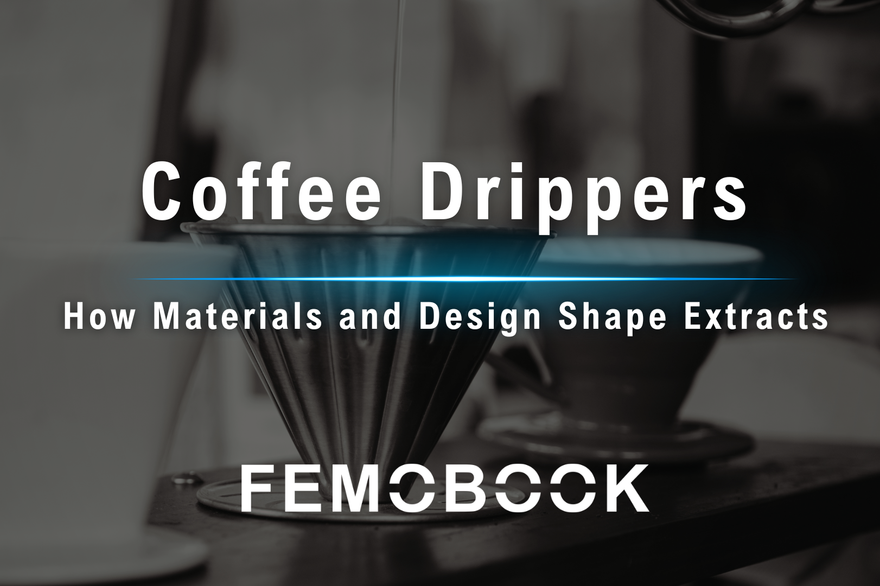In pour-over brewing, every detail matters—and the dripper you use shapes your cup more than you might think.
Different materials and internal designs change how water flows and retains heat, directly influencing extraction and flavor.
This guide breaks down what a dripper does, how material and structure affect brewing, the most common types, and popular models so you can choose the one that fits your style and taste.
What Is a Coffee Dripper?
A coffee dripper is the heart of pour-over brewing. It holds the filter and guides the water as it flows through the coffee bed. When you pour hot water over freshly ground coffee, gravity draws it down through the grounds, extracting the soluble flavors and aromatic oils that define the cup.
The paper filter traps fine particles and oils, giving pour-over coffee its signature clarity and clean finish. Most drippers come in 1–2 or 3–4 cup sizes, depending on your brew volume.
Even though the dripper only touches the water for a few minutes, it plays a big role in flavor. Its material and shape control how heat and water move through the coffee, directly affecting extraction balance and taste.
In the next section, we’ll explore how different dripper materials and designs change your brew—and how to choose one that matches your flavor goals.
【Related】:How to Make Pour-Over Coffee
How Drippers Affect Coffee Flavor
A dripper influences flavor in two main ways: temperature and flow rate. Master these, and you’ll start to understand why the same coffee can taste different in different brewers.
Temperature Stability
Drippers come in materials like plastic, metal, ceramic, and glass—each with its own heat properties. When hot water meets the dripper’s surface, some heat is absorbed, slightly changing the brewing temperature.
Temperature, in turn, is one of the biggest factors in coffee extraction. All else equal, cooler water extracts more slowly, while hotter water speeds up solubility and yields a stronger brew.
A dripper with good heat retention keeps the brewing temperature more stable, which helps maintain balanced, consistent flavor. Materials with low heat capacity, like plastic, lose less heat; others, like ceramic, absorb more and may require preheating for even results.
Flow Rate and Contact Time
Water only stays in touch with the coffee grounds for a short window—seconds to a few minutes.
The slower it flows, the more flavors it pulls out. Too slow, and you risk bitterness; too fast, and the brew runs thin and hollow.
Here’s where design matters. The dripper’s shape, ribs, and drain hole control how water travels through the coffee bed. Those grooves aren’t just there for looks—they shape the flow and decide how evenly your coffee extracts.
Coffee Dripper Materials and Their Impact

The material of a coffee dripper mainly affects heat behavior—its thermal mass (how much heat it absorbs) and insulation. In short, different materials transfer and retain heat in different ways, which influences temperature stability during brewing.
Plastic Drippers
Plastic drippers are affordable and beginner-friendly. Because they have low thermal mass, they don’t absorb much heat from the water and require little to no preheating. They’re also lightweight, durable, and resistant to drops.
However, the quality of plastic matters. Poorly made drippers can release odors or harmful substances at high temperatures, which may affect both flavor and safety. Always check the heat resistance and material specifications before buying.
Common plastics used in coffee drippers include:
-
Polypropylene (PP): Heat resistant from about 100 °C to 140 °C, resistant to acid, alkali, and impact, and BPA-free.
-
Styrene-Acrylonitrile Copolymer (SAN): Heat resistant up to about 140 °C and BPA-free.
-
Tritan™ Copolyester (modified PCT): Higher-grade plastic, heat resistant to around 96–100 °C, also BPA-free.
Ceramic Drippers
Ceramic drippers have a classic look and a solid, heavy feel. They offer excellent heat resistance and high thermal mass, which means they can noticeably lower the water temperature at the start of brewing if not preheated. With proper preheating, however, they retain heat well and support a stable, consistent extraction. The downside is that they’re heavier, more fragile, and usually more expensive than other types.
Glass Drippers
Glass drippers also offer good heat resistance and a refined, transparent design that lets you watch the extraction process—a visual bonus for pour-over brewing.
They have medium thermal mass and lower heat conductivity than metal, meaning they warm up slowly. Because their heat retention is limited, preheating is still recommended to prevent temperature drop at the start of brewing.
Glass is fragile, though, and can crack or chip if bumped. Once damaged, it’s best to replace the dripper rather than continue using it.
Stainless Steel Drippers
Some metal drippers use a built-in mesh filter, allowing you to brew without paper filters. Without paper, water flows faster and more coffee oils pass through, giving the cup a richer body and heavier mouthfeel. However, those oils can stick to the mesh surface, so thorough cleaning is essential to prevent residue from affecting the next brew’s flavor.
The thermal mass of stainless steel depends on its thickness and weight. Heavier drippers can absorb more heat and lower brewing temperature, so a quick preheat is recommended to keep extraction consistent.
Copper Drippers
Copper drippers fall under the metal category and come in both paper-filter and mesh-filter designs. Most common versions, like the copper editions of the V60 or Kalita, are used with paper filters. When designed with a metal mesh, they can be used without paper, offering faster flow and better oil retention.
Copper conducts heat more efficiently than stainless steel. Without proper preheating, it quickly absorbs heat and lowers the brewing temperature in the early stage. Preheating the dripper before brewing helps maintain stable water temperature.
Material Comparison Overview
|
Material |
Thermal Mass / Conductivity |
Preheating |
Filter Use |
Key Traits |
Pros |
Cons |
|
Plastic |
Low thermal mass / Poor heat conduction |
Not required |
Needs paper filter |
Good-quality plastic doesn’t affect flavor |
Affordable, lightweight, durable |
Check quality and heat resistance |
|
Ceramic |
High thermal mass / Slow conduction |
Proper preheating needed |
Needs paper filter |
High heat stability for consistent brewing |
Elegant look, strong heat retention |
Heavy, fragile, relatively expensive |
|
Glass |
Medium thermal mass / Slow conduction |
Recommended |
Needs paper filter |
Transparent and aesthetic |
Visually appealing, easy to observe extraction |
Low heat retention, fragile |
|
Stainless Steel |
Depends on thickness / Fast conduction |
Recommended |
Mesh models don’t need filter |
Retains more oils, faster flow |
Durable, less likely to break |
Requires regular cleaning; thick designs absorb heat quickly |
|
Copper |
Depends on thickness / Very fast conduction |
Required |
Mesh models don’t need filter |
Retains more oils, faster flow |
Excellent heat conduction, premium appearance |
Absorbs heat quickly, higher cost |
【Related】:10 Popular Coffee Brewing Methods
How Coffee Dripper Design Affects Flow and Extraction

Ribs
The “ribs” of a dripper refer to the raised lines along the inner wall. They’re not just for decoration—their design determines how tightly the paper filter sits against the dripper and helps create air channels between the two. These channels let water flow smoothly and prevent clogging when the paper sticks to the wall.
Ribs also guide the direction and speed of water as it moves through the coffee bed. Common rib patterns include vertical lines, spiral grooves, and variations in their length, height, and number.
When the filter paper, hole size, and base shape are similar, longer, taller, or more numerous ribs create more space between paper and dripper. This increases flow speed and slightly shortens the contact time between water and coffee grounds.
The rib design must balance open flow channels with smooth surfaces to ensure even extraction and consistent performance.
Dripper Base Shapes
Most coffee drippers come in two base shapes: cone-shaped and flat-bottom.
Under similar brewing conditions—same grind size, filter, and pouring style—the flat-bottom dripper drains more slowly, allowing longer extraction time. The cone-shaped dripper, by contrast, promotes faster flow.
These structural differences directly affect extraction time and flavor, making the base shape one of the key factors to consider when choosing a dripper.
Dripper Holes
After passing through the coffee grounds, water exits the dripper through the holes at the bottom—its final pathway before reaching the carafe.
The size and number of these holes directly affect the flow rate. Smaller holes slow down drainage, while larger or multiple holes let water flow faster. Flow rate determines how long the water stays in contact with the coffee grounds, which in turn influences the extraction level and the final flavor in the cup.
8 Popular Pour-Over Drippers
1. Hario V60
Designed by Japan’s Hario, the V60 coffee dripper is one of the most iconic pour-over brewers in the world. Its V-shaped cone has a 60-degree angle—hence the name—and spiral ribs along the inner wall. The bottom features a single large hole that promotes faster flow and greater control over pouring technique.
The Hario V60 series comes in a wide range of materials—plastic, glass, ceramic, stainless steel, and copper—and is available in multiple sizes.
2. Hario V60 Switch
The Hario V60 Switch is a variation of the classic V60, featuring a switchable valve at the bottom that allows you to control water flow. With the valve closed, it holds the water and coffee grounds together for longer immersion, combining the strengths of both immersion and percolation brewing.
When opened, it functions like a regular V60, giving brewers flexible control and a wider range of flavor outcomes.
3. Kalita HA 102
The Kalita HA 102 is a classic trapezoid-shaped dripper from Japan’s Kalita. It features three small drain holes on the bottom and straight vertical ribs along the inner wall.
Compared with the Hario V60, its base is flatter; and compared with Kalita’s own Wave model, it has a slightly more conical curve.
The HA 102 comes in various materials, including plastic and ceramic, and even a Hasami ware version made with traditional Japanese craftsmanship.
4. Kalita Wave
The Kalita Wave has an even flatter base than the HA 102, so the two models use different filter shapes. Its signature three-hole design works together with the wavy filter paper to maintain a stable flow and improve extraction consistency.
5. Melitta 101
The Melitta 101, a classic trapezoid-shaped dripper from Germany’s Melitta, features ribs that run only along the lower half of the inner wall. This design allows the filter paper to fit tightly against the dripper, extending the contact time between water and coffee grounds and enhancing extraction strength and flavor intensity. It uses a single-hole base design.
6. Clever Dripper
The Clever Dripper, designed by Taiwan’s Abid Company, combines both immersion and percolation brewing methods. A patented valve at the bottom controls when the brewed coffee is released. The design makes it simple to operate, easy to repeat consistently, and very beginner-friendly—qualities that have earned it international recognition.
Made from durable modified PCT plastic, the Clever Dripper has fewer and shallower ribs inside, but since it brews by immersion, rib structure has little effect on flow. It still delivers stable and balanced flavor with every brew.
7. Driver Diamond Dripper
Developed by Taiwan’s Chun-Yi Enterprise, the Driver Diamond Dripper features a cone-shaped body with a single-hole base. Its most distinctive feature is the diamond-cut lattice pattern on the inner ribs, designed to enhance air circulation and water flow for more uniform extraction.
8. Kinto Octagon Dripper
The Kinto Octagon Dripper from Japan stands out for its distinctive geometric design. The body features clean, angular lines forming an octagonal shape, while the interior is smoothly curved for balanced flow.
A single octagon-shaped hole at the bottom controls drainage, and the straight ribs taper from wide to narrow, helping regulate water flow speed. The inner and outer walls are set at slightly different heights, making it easier to remove the filter paper—a thoughtful detail that reflects Kinto’s minimalist design approach.
Femobook Electric Coffee Grinder
The beauty of pour-over coffee lies in countless small details, and bean freshness is one of the most important. Using freshly roasted beans and grinding right before brewing brings out far greater depth and aroma.
The Femobook A4Z electric grinder, designed specifically for pour-over brewing, delivers professional-level performance in a compact home size. It offers more than 300 precise grind settings, allowing fine control over particle size for any brewing preference.
A magnetic assembly system makes disassembly and cleaning quick and intuitive, ensuring every grind captures the pure aroma and flavor of your freshly ground coffee









